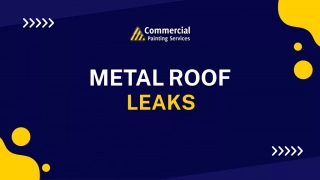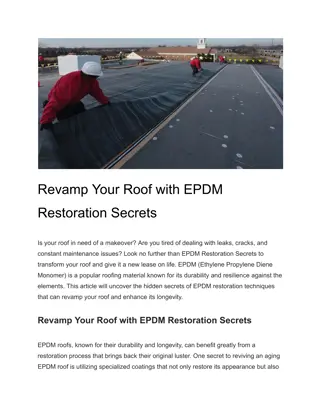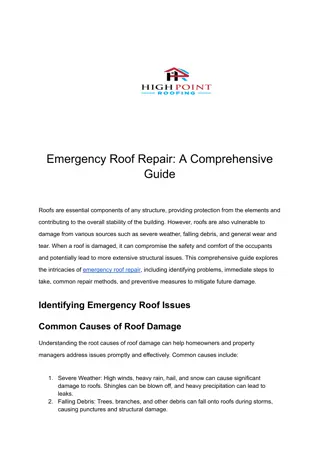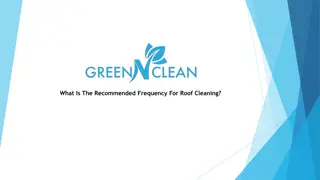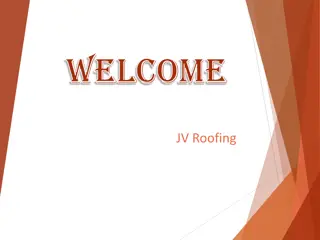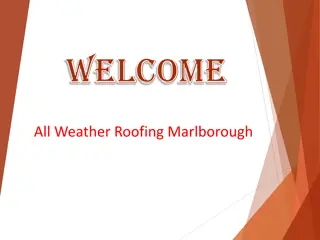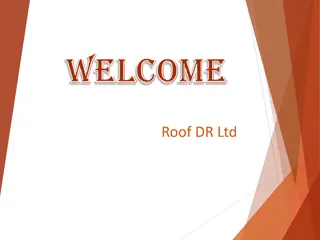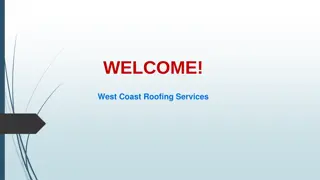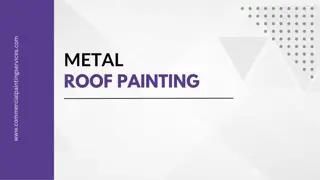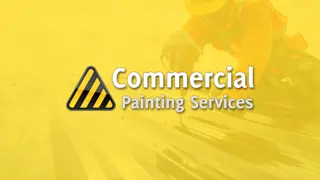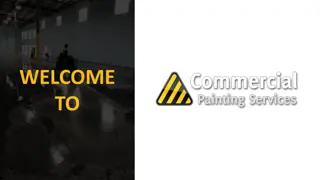
Commercial Building Roof Waterproofing
Roofs are often a neglected part of buildings or houses but they require proper regular maintenance or (roof) restoration to avoid leakages and any other damages. The waterproofing problem is more prominent in commercial building flat roofs because they have a shallow slope making it more difficult for water to slide off, unlike sloped roofs on which water slides off easily.nn
Download Presentation

Please find below an Image/Link to download the presentation.
The content on the website is provided AS IS for your information and personal use only. It may not be sold, licensed, or shared on other websites without obtaining consent from the author. If you encounter any issues during the download, it is possible that the publisher has removed the file from their server.
You are allowed to download the files provided on this website for personal or commercial use, subject to the condition that they are used lawfully. All files are the property of their respective owners.
The content on the website is provided AS IS for your information and personal use only. It may not be sold, licensed, or shared on other websites without obtaining consent from the author.
E N D
Presentation Transcript
Commercial Building Roof Waterproofing Roofs are often a neglected part of buildings or houses but they require proper regular maintenance or (roof) restoration to avoid leakages and any other damages. The waterproofing problem is more prominent in commercial building flat roofs because they have a shallow slope making it more difficult for water to slide off, unlike sloped roofs on which water slides off easily. Waterproofing is a form of roof maintenance to make sure your commercial roofing system is stable and long-lasting. Standing water blocks the drainage system due to collected leaves that can be detrimental to the roof s health in the long term. Also read about: Commercial Roofing Restoration Trends in 2024 Roof waterproofing is more complex when dealing with flat roofs. You might have heard that the protective membrane of your roof can get damaged if the rainwater begins to gather in some places for a long time. For repair, normally a pressure washer is used to clear off the debris by removing algae or other hard-to-remove moss. How to waterproof a commercial building flat roofing system
There are three major methods of waterproofing a commercial building flat roof. For flat roof restoration services related to waterproofing, you need to know which approach seems more applicable. It depends on several factors such as weather, budget, roof size, environment, and structure type. 1. Reinforced Bitumen Membranes: This is the most common method of commercial building roof repair. Industrial roof restoration through waterproofing involves two or three layers of bitumen stuck together and placed on the flat roof. It is then combined with a polyester carrier to create a waterproofing material. It is the supreme form of protection against winds and rainwater. Different methods to attach this amalgam to the roof for flat roof restoration are through gas torch, cold application method, self-adhesive. You can use hot material amalgam to seal the material to the flat roof. Use of single-play membranes: Membrane roof restoration offers protection of the roof through sheet installation. Normally the sheet is installed all over the roof if required. Expensive residential places and larger commercial buildings often opt for this method of waterproofing flat roofs through ballasting, adhesion, and fastening. Adhesives to connect singly play membrane and insulation are called as polyurethane adhesives. Different kinds of fasteners are used for ply membrane roof protection and restoration. Sheets are attached to the roof through plastic fasteners. This allows them to stay in place and be placed directly on top of sheets. Liquid waterproofing: Another method for roof restoration is liquid waterproofing. This type of industrial roofing waterproofing requires a special type of coating for the flat roofing system. Flat roofing contractors normally use liquid waterproofing for flat roofs. As an industrial roof restoration liquid waterproofing lasts for 20-40 years. The longevity of waterproofing on a flat roof depends on the installation process, maintenance of a flat roof once liquid waterproofing coating is installed, and its quality. Different types of liquid waterproofing include fleece and fiberglass liquid membranes. TPO roofing membrane: A membrane of Thermoplastic polyolefin (TPO) is the best way to use the membrane waterproofing technique. They are not only energy-efficient but also very affordable to waterproof your industrial flat roof.
The material of TPO is lightweight and provides effective waterproofing of commercial building flat roofs. Other roofing membranes involve PVC roofing membrane made of Polyvinyl chloride (PVC), which comes in a variety of colors and is easy to use. However, PVC is expensive as compared to TPO. The membrane is waterproof and durable, perfect for drying your flat roof. Plus, the material is lightweight and easy to install. Normally the roof is exposed to a lot of external elements shortening its life span however different roofing methods and techniques like waterproofing flat roofs or using EPDM roofing can save your roof from long-term damage. Waterproofing prevents roof repair in the future so it is important to adapt to waterproofing techniques. Whether you want to provide waterproofing, just know that we take responsibility from the beginning till the end of the process. If you have faced any leakage problem or there is debris accumulated on your flat commercial building roof, worry not, Roof Restore 5X use compatible adhesives to ensure the perfect installation for a perfect seal. We have the know-how and experience with waterproofing commercial building flat roofs so you don t have to worry about leaks or damages. Connect with us now.

